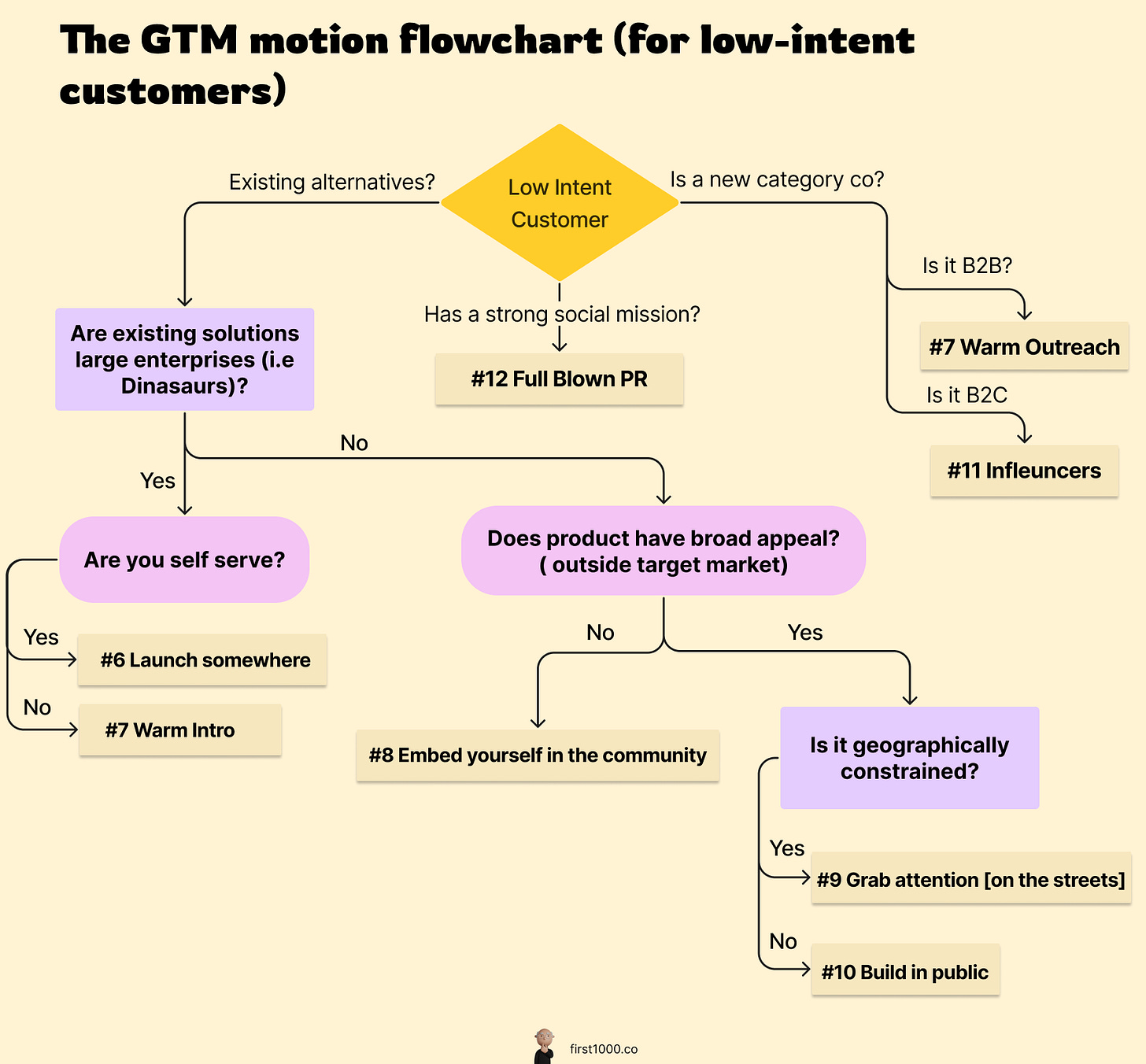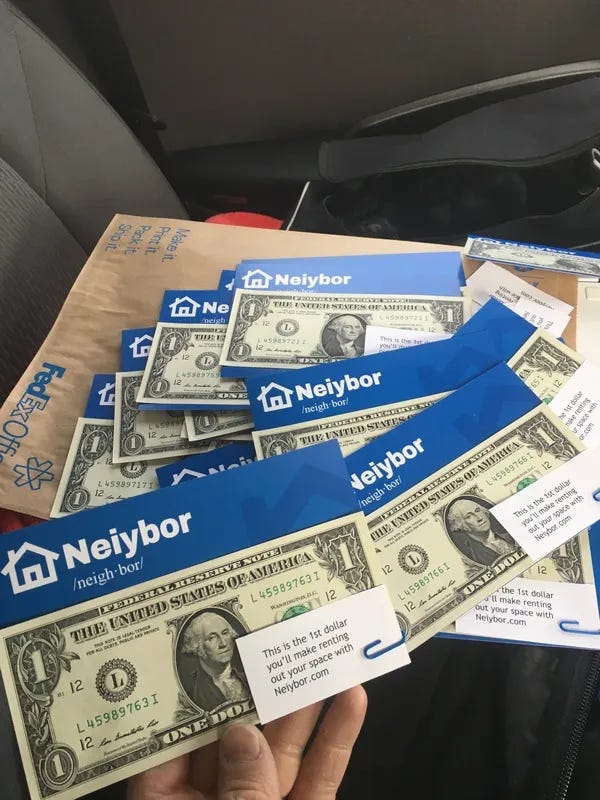100 Unicorns: 12 different GTM Motions
I am back!!
I will share more on my long hiatus next issue!
Today I’ll be walking through the maze of GTM motions! A GTM motion is the answer to two questions:
How do people hear about your product?
Why do they buy it?
And the answers are correlated. In the two flowcharts below, I use reasons consumers adopt a new solution to arrive at the most commonly utilized channel, based on my research of 120+ 🦄 and public companies.
For High-intent Customers
If you are building something people already know they need
#1 Produce discoverable Content
Ideal for: If the customer is high intent, actively searching the internet for a solution & is frustrated by the lack of a viable solution for their needs
Examples:
Zapier: Zapier found its first customers by scouring tech forums for people interested in integrations that were not officially supported.
Gemini: Gemini took off by posting in crypto circles and communities about being the first fully licensed and compliant bitcoin and (soon after) ether exchange worldwide. Serious banking clients had no alternatives. [Source]
#2 Create a Super-fan by over-servicing one customer at a time.
Ideal for: If the customer is high intent, not actively searching for a solution & requires a complex nuanced solution for their particular use-case.
Examples:
Vanta: Christina(one of the co-founders) heard that the Segment team was struggling with SOC-2 compliance. She proactively sent the team a spreadsheet outlining steps to take to ensure compliance [Source]
Substack: Hamish (one of the co-founders) knew that Bill Bishop (a renowned internet writer) wanted to create a subscription for his publication so he & the team @ Substack worked maniacally close with Bill to create v1 of the product [Source].
Check: Got the “idea” from their first client, Homebase, who wanted to offer payroll but would not dare touch it because of how complicated and expensive payroll is. They worked together to produce the first version of Check [Source].
#3 Hack a distribution channel
Ideal for: If the customer is high intent, not actively searching for a solution & the offering is straightforward
Examples:
Whatsapp: Founders kept changing the name of the app so it will be featured in the "What's new" section of the app store with every update [Source]
Tiktok: Appended “for Facebook & Instagram” at the end of the app name on the app store to get discovered by people looking for Facebook or Instagram. [Source]
Paypal: Created bots that reached out to eBay sellers pretending to be real customers and insisting on paying only via PayPal. [Source]
#4 Fish on Forums
Ideal for: If there are many alternative solutions and there is little to no lock-in to adapt a new offering.
Examples:
Postman: Postman was introduced to the world as a StackOverflow reply - a lightweight tool that Abhinav(cofounder) thought might help developers test and debug APIs in a much more productive manner. [Source]
Veed: Founder answered over 100 questions on Quora about video editing software. [Source]
Ahrefs: Bought Ads in targeted forums for SEO specialists and marketers. [Source]
For Low-Intent Customers
If you are building something people don’t know they need yet!
#5 Cold Outreach [w/ a hook]
Ideal for: If the customer is low-intent, there are many alternative solutions and adapting a new solution is a pain.
Examples
Zoom: After reaching out to Stanford University, Eric (Founder of Zoom) entered Zoom in a competitive bid with other more established industry players. Zoom won by offering a more reliable product at an affordable price. [Source]
TripActions: Ariel sold TripActions by reaching out to large-enterprise CFOs/CXOs offering their companies the ability to save money on company travel by leveraging the unique TripActions employee rebate program. [Source]
HingeHealth: Reached out to Fortune 500 Benefits Execs of blue-collar heavy companies offering a solution to take over the headache of managing MSK (a back chronic disease) for their employees. [Source]
#6 Launch somewhere [& get PR — Optional]
Ideal for: If the customer is low-intent (not actively searching for alternatives), the market is dominated by legacy players, and your offering is self-serve.
Examples
Notion: Notion’s launch on product hunt and smaller, more targeted channels resulted in the big PR wave, likely due to the unique use case the product enabled (multi-player + single-player productivity). [Source]
Twilio: Twilio launched on Techcrunch after an angel investor used the service to prank Michael Arrington, the co-founder of Techcrunch. [Source]
Fast: Fast had a massive launch predicated on the company’s build-in public movement that garnered much attention from high-profile investors and influencers in the venture capital space. [Source]
#7 Warm Outreach [Sell relationship or credibility]
Ideal for: If the customer is low-intent (not actively searching for alternatives), the market is dominated by legacy players, and your offering requires integration or infrastructure work.
Examples
Workday: According to the Founder, Workday's earliest customer bought the friendship, not the software. They were mostly midsized companies where the founder knew the CEOs personally [Source]
Charli HR: The founder visited initial customers, manually onboarded them, and built a great relationship with them. He then ask them to tell a friend - that’s how they got from 5-10 customers to 20-30 pretty fast! [Source]
—
Also ideal for: If the customer is low-intent (not actively searching for alternatives) and the market is not yet established.
Examples:
DataRobot: DataRobot got its first customers by warm intros, selling a data-science-in-a-box platform backed by the credibility of its founders. [Source]
#8 Embed yourself in the community [authentically]
Ideal for: If the customer is low-intent (not actively searching for alternatives), the market is not dominated by legacy players 🦕 and the offering has a niche appeal
Examples
Github: Gained traction from founders being heavily involved in the ruby on rails community and offering a headache-free way to host git projects (there was a decent overlap between Ruby on Rails communities and early-git fanatics) [Source]
Coinbase: Brian (founder of Coinbase) offered members of varies crypto communities 0.1BTC for feedback on the product.
Snackpass: Similar to Facebook, Snackpass grew like 🔥 by infiltrating on-campus communities and offering a new form of communication within the community (through Snackpass gifts) [Source]
#9 Grab attention [on the streets]
Ideal for: If the customer is low-intent (not actively searching for alternatives), the market is not dominated by legacy players 🦕 and the offering is geographically constrained.
Examples
Neighbor: Neighbor used flyers to spread the word about the product. To get people’s attention, they paper clipped a dollar bill with a note saying ‘this is the first dollar you’ll make renting out your space on neiybor.com [Source]
GoPuff: Gopuff grabbed many 👀👀 by offering a “one-stop puff shop” for pot and tobacco smokers, delivering equipment like hookahs, vaporizers, grinders, and rolling papers for late-night orders on the Drexel University campus. [Source]
Thursday: The dating app Honeypot (now Thursday) got its first users by placing whiteboards with quirky messages around the streets of London. [Source]
#10 Building in Public
Ideal for: If the customer is low-intent (not actively searching for alternatives), the market is not dominated by legacy players 🦕 and the offering has a wide appeal.
Examples:
Buffer: Leo Wildrich (cofounder) wrote 150 guest posts in the first 9 months of running Buffer. [Source]
DesignJoy: Brett (creator) regularly shared his progress on indiehackers.com, a well-known community for indie makers.
Pave: Employees were encouraged to share industry-wide salary stats (the main company offering) on Linkedin, which garnered a lot of attention.
#11 Influencers
Ideal for: If the customer is low-intent (not actively searching for alternatives), market is not dominated by legacy players 🦕 and the offering has a wide appeal.
Examples:
Spotify: Founders asked music bloggers to beta test the MVP. The product was impressive enough in one particular aspect: speed. This gave bloggers an interesting angle to write about.
Canva: Melanie Perkins (cofounder) aggressively reached out to graphic design influencers to find some win-win scenarios to get influencer power behind her design-in-a-box solution
Medium: Ev Williams (who cofounded Twitter before Medium) tapped his network to get influencers as early adopters of the product. President Obama was amongst this cohort of influencer early adopters [Source]
—
Also Ideal for: If the customer is low-intent and the offering is a consumer product in a new emerging category.
Examples
Linkedin: Reid Hoffman (also ex-COO Paypal) utilized his network of influential people in the Tech Space to kickstart Linkedin
Product Hunt: Only technology heavy-hitters (bloggers and influencers) were allowed to hunt products on the site to maintain a high-quality bar and drum up interest in the site.
Step: Step, the Kid-focused neobank penned a deal with the #2 followed TikToker: Charli D-Amelio, to invest and promote the product. [Source]
#12 Full Blown PR
Ideal for: Low Intent customers for products with a strong social mission 🌳🌞.
Examples
Telegram: Durov (who also created the “Facebook of Russia” and had a very public altercation with the government ) started Telegram as a revenge business that stood for user privacy and against government surveillance.
Hey: The Hey email client launched with a full Manifesto that stood for user privacy and control. [Source]
I am open sourcing my full research here with 100+ more examples
Until we meet next Tuesday,
Ali Abouelatta





